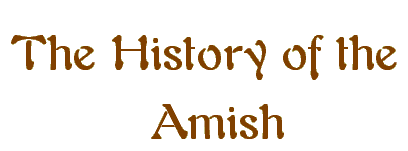The Amish derive their name from Jakob Amman, an early Swiss Mennonite bishop. Amman was origianlly part of the religious group of Mennonites called Anabaptists (Re-Baptizers). The Anabaptists went against the traditional teaching in Europe of infant baptism, and instead believed that only adults should be baptized because infants do not have knowledge of good and evil. Jakob Amman created a schism in the German Anabaptist-Menonnite groups during the late 17th century. Amman believed and taught strict practices such as avoidance or shunning (also called Meidung) towards those who are excommunicated. Two other beliefs he insisted upon were foot washing and communing two times a year, rather than the tradition of once a year. The other Mennonite leaders did not agree with Amman's reforms. Therefore, a new religious division was formed known as the "Amish" under Jacob Amman's leadership.

While in Europe, the Amish experienced harsh persecution because of their nonconformity and many were put in sacks and thrown into the rivers. The only Amish that survived are those who escaped the genocide by coming to the United States in the 18th Century. There are no Amish existing in Europe today. The Amish immigrated to Pennsylvania because William Penn had created a haven there for others experiencing religious persecution. The Amish immigration was the greatest between 1727 and 1770 and the Charming Nancy was the ship that brought the most Amish passengers to Philadelphia in 1737. Most of the Amish groups settled in Lancaster county which continues to be one of the most famous Amish communities today.
Some internal divisions occured over controversies of interpretations of the "Ordnung", the common order of life for the Amish, during the 19th century. The communities gradually formed separate groups of conservative and more progressive Amish. The conservative Amish are commonly referred to as the "Old Order Amish." They believe the "Ordnung" gives physical and literal expression of Biblical teachings and virtue. The progressive Amish, on the other hand, are called "Amish Mennonite" and they believe that these teachings and virtues can be expressed in other ways as well as literally. All of the Amish groups hold to the Bible verse "Be ye not conformed to the world but be ye transformed..." (Romans 12:2) as their chief tenet of living.
The Amish people speak a German dialect called Pennsylvania Dutch (Deutsch). During worship services they use High German. They learn English at school and only go to school until the eighth grade. The Amish experienced a controversy during the 20th century when the state sought to require Amish children to receive schooling until the age of 16. In the case of Wisconsin v. Yoder (1972), the Supreme Court decided that it was unconstitutional to force Amish children to attend school into high school because of their right to the free exercise of their religion.
The Amish today live in 22 states including Pennsylvania, Ohio, Indiana, and Illinois. The total of all Amish groups probably number 100,000 in all 22 states including about 45,000 in Ohio. There are about 1,500 Amish living in Ontario Canada. Almost all members of the Amish community are descendants of Amish parents and only ten percent are believed to be converts.

References:
Origins of the Old Order Amish
The Amish, the Mennonites
The Amish: Beliefs, Practices, Conflicts
Amish Division
Amish
The Amish



